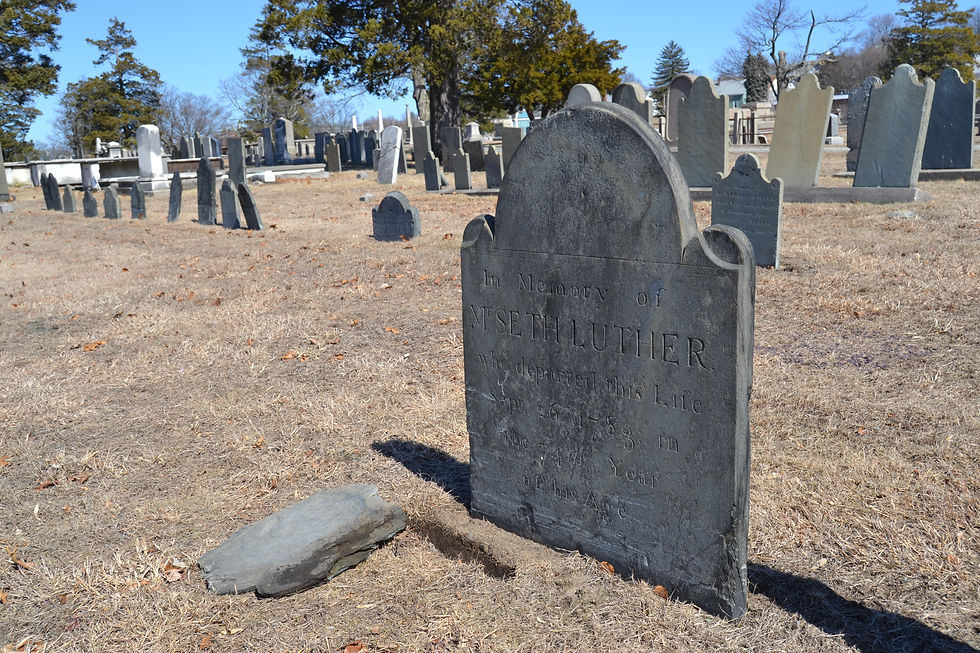%20Landscape%20Waypt.jpg)
Seth Luther
(1709-1785)
Seth Luther was born in Swansea Massachusetts November 23, 1709, the son of Joshua and Experience Luther. He came to Providence in the mid 1750’s with his family living on land inherited from his father in law, noted Providence stone carver, John Anthony Angel. A number of features characterize Luther’s gravestone folk art such as intense, bulging eyes with tiny pupils looking to the heavens. Luther died in Providence in 1785.
Gallery




Seth Luther (1709-1785)
Seth Luther was born in Swansea Mass Nov 23, 1709, the son of Joshua and Experience Luther. He lived in Rehoboth and married in 1733 Mary Vorce (Vose). After Mary’s death Luther married Mrs. Esther Brightman in Portsmouth September 25, 1740. He resided at Newport and was a freeman by 1742. Luther was a house wright by trade. He moved to Portsmouth but then moved to Providence when he inherited John Anthony Angell’s land. Angel too was a noted stone carver whose house, shop and land were close by the North Burial Ground. In 1757 Luther became a freeman in Providence and in 1764 he received a grant of 50 share feet in NBG when the boundaries were revised. He may have moved to Nova Scotia at some point but died in Providence September 26, 1785.
According to Professor Luti Seth Luther broke new ground in the folk art traditions of 18th century gravestone carving. His style was innovative, distinct, bold and recognizable and set him apart from other stone carvers. The North Burial Ground is a repository of a number of his works carved between the 1750’s and his own death in 1785. Ironically, while many of the stones he carved remain preserved enough to appreciate his stylistic details, his own gravestone carving is barely legible.
Professor Luti points to a number of features characterized Luther’s gravestone folk art. His choice of stone where possible was a weathered, grainy, light tan or gray which over time tends to be more purple. According to Luti, Seth Luther effigies typically wore wigs of tiers of tight, yarn like curls; they had intense, bulging eyes with tiny pupils looking to the heavens. Great floral crowns and large wings with segmented feathers are characteristic of Luther’s carvings. Other features such as the borders and columns are stylized, abstract and filled with winding florals. Professor Luti was unsure if the abstractions was due to lack of skill in naturalistic design or was an imaginative folk art in a time of rococo and neo-classical tastes.
The accompanying Power Point contains the same sampling of North Burial Ground stones carved by Luther that Professor Luti published in his 1981 article “Seth Luther, Stonecarver of Narragansett Bay.” Luther’s distinctive style and his deep bold cutting style has helped preserve his work. Click here to view his stonework and that of John Anthony Angel, who until his death in 1756, worked with Luther.
This biography is based largely on an article by Professor Vincent Luti entitled “Seth Luther, Stonecarver of the Narragansett Bay,” Rhode Island History Volume 39:1 February 1980 pp. 3-13.
Harriette Merrifield Forbes classic work entitled Notes from Gravestones of Early New England and the Men Who Made Them 1653-1800 ( Boston: Houghton Mifflin 1927) remains a fascinating work on the symbolism and iconography found in early New England Burial grounds.
Also see Douglas Keister, Stories in Stone: A Field Guide to Cemetery Symbolism and Iconography (New York: MJF Books, 2004) and Alan Ludwig, Graven Images: New England Stonecarving and its Symbols, 1650-1815. (Hanover NH: University Press of New England, 1999).
%20Landscape%20Waypt.jpg)




